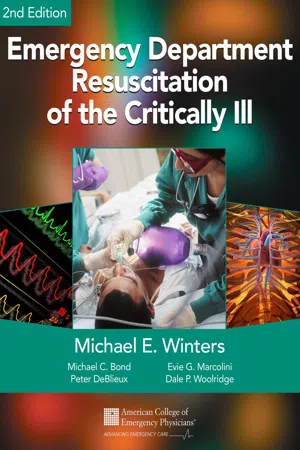
Emergency Department Resuscitation of the Critically Ill, 2nd Edition
A Crash Course in Critical Care
- English
- ePUB (mobile friendly)
- Available on iOS & Android
Emergency Department Resuscitation of the Critically Ill, 2nd Edition
A Crash Course in Critical Care
About this book
A Crash Course in Critical Care!
Stabilize, treat, and save your sickest patients – in the ED or the field – with ACEP’s ultimate resuscitation guide. Packed with succinct evidence-based chapters written by the nation’s foremost authorities.
The second edition emphasizes:
- ECMO, sepsis, neuro, critical care, pulmonary hypertension, crashing obese patient, neonatal
- The addition of many new flow diagrams and diagnostic and treatment algorithms
- In-depth, up-to-date descriptions of the unique presentation, differential diagnosis, and management of specific critical illnesses
The ability to manage critically ill patients is perhaps the defining skill of emergency physicians. Whether performing rapid sequence intubation, initiating and adjusting mechanical ventilation, titrating vasoactive medications, administering intravenous fluids, or initiating extracorporeal membrane oxygenation, emergency clinicians must be at their best in these high-octane scenarios, during which lives can be saved—or lost.
Emergency Department Resuscitation of the Critically Ill focuses on caring for the sickest of the sick: the unstable patient with undifferentiated shock; the crashing ventilated patient; the decompensating patient with pulmonary hypertension or septic shock; the crashing obese patient; or the hypotensive patient with a left ventricular assist device. You’ll also find imperative information about managing pediatric and neonatal resuscitation, intracerebral hemorrhage, and the difficult emergency delivery.
What physiological possibilities must you consider immediately? What steps should you take now to save the patient’s life? The country’s foremost emergency medicine experts tell you everything you need to know to deliver rapid, efficient, and appropriate critical care. Quite simply, this book will help you save lives.
Frequently asked questions
- Essential is ideal for learners and professionals who enjoy exploring a wide range of subjects. Access the Essential Library with 800,000+ trusted titles and best-sellers across business, personal growth, and the humanities. Includes unlimited reading time and Standard Read Aloud voice.
- Complete: Perfect for advanced learners and researchers needing full, unrestricted access. Unlock 1.4M+ books across hundreds of subjects, including academic and specialized titles. The Complete Plan also includes advanced features like Premium Read Aloud and Research Assistant.
Please note we cannot support devices running on iOS 13 and Android 7 or earlier. Learn more about using the app.
Information

IN THIS CHAPTER
Initial Assessment
- Blood glucose measurement to screen for hypoglycemia
- Pregnancy test in female patients of childbearing age for suspected ectopic pregnancy
- ECG to identify arrhythmia and ischemia
- Assessment of feet and hands of abnorm vasodilation
- Examination of the neck veins as an indicator of paradoxically increased central venous pressure
- Rectal examination for melena/gastrointestinal blood for occult bleeding
- Chest radioraph to evaluate for pneumonia, pneumothorax or hemothorax, pulmonary edema
Initial Stabilization
Table of contents
- Disclaimer and Copyright Notice
- iii About the Editors
- ivDedications
- Acknowledgments
- vContributors
- viiiForeword
- ixPreface
- xiContents
- 1: Undifferentiated Shock
- 2: The Difficult Airway
- 3: The Crashing Ventilated Patient
- 4: Fluid Management
- 5: Cardiac Arrest Updates
- 6: Postcardiac Arrest Management
- 7: Deadly Arrhythmias
- 8: Cardiogenic Shock
- 9: Extracorporeal Membrane Oxygenation
- 10: Cardiac Tamponade
- 11: Aortic Catastrophes
- 12: Severe Sepsis and Septic Shock
- 13: The Crashing Morbidly Obese Patient
- 14: Pulmonary Hypertension
- 15: Left Ventricular Assist Devices
- 16: The Critically Ill Poisoned Patient
- 17: The Crashing Trauma Patient
- 18: Emergency Transfusions
- 19: Intracerebral Hemorrhage
- 20: Subarachnoid Hemorrhage
- 21: The Crashing Anaphylaxis Patient
- 22: Bedside Ultrasonography
- 23: The Difficult Emergency Delivery
- 24: Neonatal Resuscitation
- 25: Pediatric Resuscitation
- Index